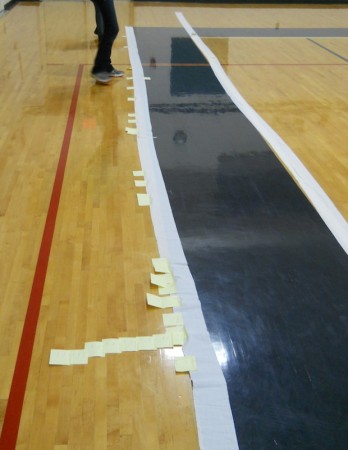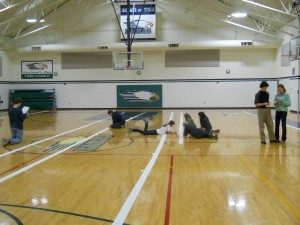With a larger class, and quite a bit of space in the gym, I had more flexibility working on the toilet paper timeline compared to the last time.

I built in a friendly race to see which group could find a set of events first, and allowed me to highlight nine different, important, series of events along the timeline.
The adapted spreadsheet, racing sequences, and a short summative quiz are on this Toilet Paper Timeline spreadsheet.
I broke the class up into 4 groups of 4, and each group created their own timeline based on a handout.

Then, I gave each group a slip of paper with four events on it (one event per student), and they had to race to see which group would be first to get one person to each event on the list. Once each group got themselves sorted out, I took a few minutes to talk about why the events were important and how they were related.
Table 1: The series of events.
| 1) We’ll be talking about plate tectonics soon, so it’s good for them to start thinking about the timing of the formation and breakup of the supercontinents. | |||
|---|---|---|---|
| Event 1 | Event 2 | Event 3 | Event 4 |
| Formation of Rodinia (supercontinent) | Breakup of Rodina | Formation of Pangea | Breakup of Pangea |
| 2) This sequence emphasizes the fact that most free oxygen in the atmosphere comes from ocean plants (plankton especially), and that a lot of free atmospheric oxygen was needed to to form the ozone layer which protected the Earth’s surface from uv radiation, which made the land much more amenable to life. Also, trees came way after first plants and oxygen in the atmosphere. | |||
| Event 1 | Event 2 | Event 3 | Event 4 |
| First life (stromatolites) | Oxygen buildup in atmosphere | First land plants | First Trees |
| 3) Pointing out that flowering plants came after trees. | |||
| Event 1 | Event 2 | Event 3 | Event 4 |
| First life | First land plants | First trees | First flowering plants |
| 4) The Cambrian explosion, where multicellular life really took off, happened pretty late in timeline. Longer after the first life and first single-celled animals. | |||
| Event 1 | Event 2 | Event 3 | Event 4 |
| First life (stromatolites) | First animals | First multicelled organisms | Rise of multicelled organisms |
| 5) Moving down the phylogenetic tree from mammals to humans shows the relationship between the tree and evolution over time. | |||
| Event 1 | Event 2 | Event 3 | Event 4 |
| First mammals | First Primates | Homo erectus | Homo sapiens |
| 6) More tectonic events we’ll be talking about later. | |||
| Event 1 | Event 2 | Event 3 | Event 4 |
| Opening of the Atlantic Ocean | Linking of North and South America | India collides with Asia | Opening of the Red Sea |
| 7) Pointing out that life on land probably needed the magnetic field to protect from the solar wind (in addition to the ozone layer). | |||
| Event 1 | Event 2 | Event 3 | Event 4 |
| Formation of the Earth | First life | Formation of the Magnetic Field | First land plants |
| 8) Fish came before insect. This one seemed to stick in students’ minds. | |||
| Event 1 | Event 2 | Event 3 | Event 4 |
| First Fish | First Insects | First Dinosaurs | First Mammals |
| 9) Mammals came before the dinosaurs went extinct. This allowed a discussion of theories of why the dinosaurs went extinct (disease, asteroid, mammals eating the eggs, volcanic eruption in Deccan) and how paleontologists might test the theories. | |||
| Event 1 | Event 2 | Event 3 | Event 4 |
| First Dinosaurs | First Mammals | Dinosaur Extinction | First Primates |
The whole exercise took a few hours but I think it worked out very well. The following day I gave the quiz, posted in the excel file, where they had to figure out which of two events came first, and the students did a decent job at that as well.